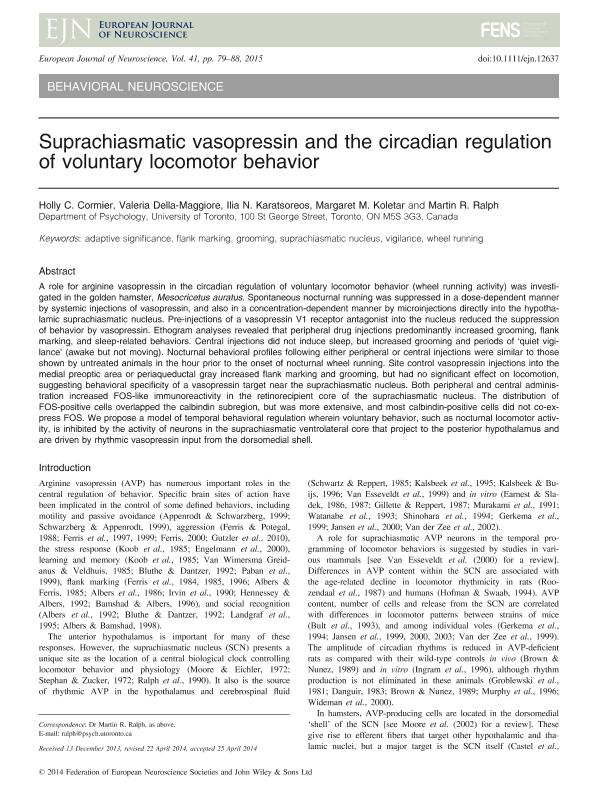Artículo
Suprachiasmatic vasopressin and the circadian regulation of voluntary locomotor behavior
Cormier, Holly C.; Della Maggiore, Valeria Monica ; Karatsoreos, Ilia N; Koletar, Margaret M.; Ralph, Martin R.
; Karatsoreos, Ilia N; Koletar, Margaret M.; Ralph, Martin R.
 ; Karatsoreos, Ilia N; Koletar, Margaret M.; Ralph, Martin R.
; Karatsoreos, Ilia N; Koletar, Margaret M.; Ralph, Martin R.
Fecha de publicación:
01/2015
Editorial:
Wiley Blackwell Publishing, Inc
Revista:
European Journal Of Neuroscience
ISSN:
0953-816X
Idioma:
Inglés
Tipo de recurso:
Artículo publicado
Clasificación temática:
Resumen
A role for arginine vasopressin in the circadian regulation of voluntary locomotor behavior (wheel running activity) was investigated in the golden hamster, Mesocricetus auratus. Spontaneous nocturnal running was suppressed in a dose-dependent manner by systemic injections of vasopressin, and also in a concentration-dependent manner by microinjections directly into the hypothalamic suprachiasmatic nucleus. Pre-injections of a vasopressin V1 receptor antagonist into the nucleus reduced the suppression of behavior by vasopressin. Ethogram analyses revealed that peripheral drug injections predominantly increased grooming, flank marking, and sleep-related behaviors. Central injections did not induce sleep, but increased grooming and periods of ´quiet vigilance´ (awake but not moving). Nocturnal behavioral profiles following either peripheral or central injections were similar to those shown by untreated animals in the hour prior to the onset of nocturnal wheel running. Site control vasopressin injections into the medial preoptic area or periaqueductal gray increased flank marking and grooming, but had no significant effect on locomotion, suggesting behavioral specificity of a vasopressin target near the suprachiasmatic nucleus. Both peripheral and central administration increased FOS-like immunoreactivity in the retinorecipient core of the suprachiasmatic nucleus. The distribution of FOS-positive cells overlapped the calbindin subregion, but was more extensive, and most calbindin-positive cells did not co-express FOS. We propose a model of temporal behavioral regulation wherein voluntary behavior, such as nocturnal locomotor activity, is inhibited by the activity of neurons in the suprachiasmatic ventrolateral core that project to the posterior hypothalamus and are driven by rhythmic vasopressin input from the dorsomedial shell.
Palabras clave:
vasopressine
,
circadian rhythms
,
running wheel
,
posterior hypothalamus
Archivos asociados
Licencia
Identificadores
Colecciones
Articulos(IFIBIO HOUSSAY)
Articulos de INSTITUTO DE FISIOLOGIA Y BIOFISICA BERNARDO HOUSSAY
Articulos de INSTITUTO DE FISIOLOGIA Y BIOFISICA BERNARDO HOUSSAY
Citación
Cormier, Holly C.; Della Maggiore, Valeria Monica; Karatsoreos, Ilia N; Koletar, Margaret M.; Ralph, Martin R.; Suprachiasmatic vasopressin and the circadian regulation of voluntary locomotor behavior; Wiley Blackwell Publishing, Inc; European Journal Of Neuroscience; 41; 1; 1-2015; 79-88
Compartir
Altmétricas



